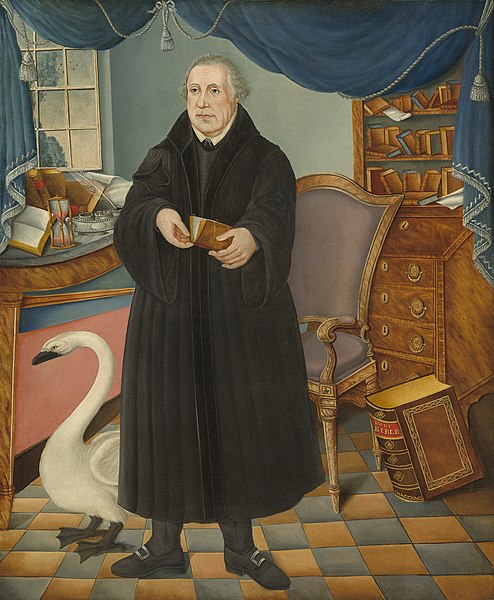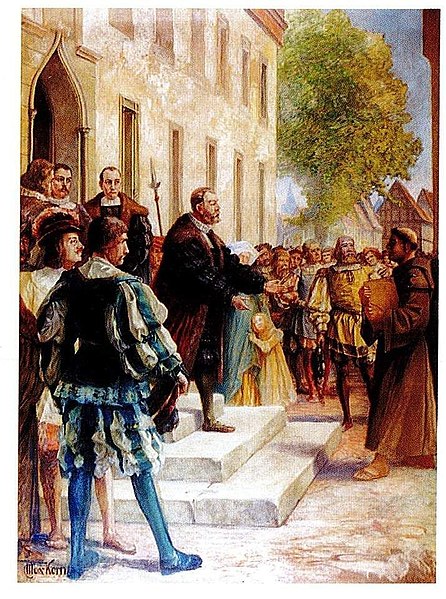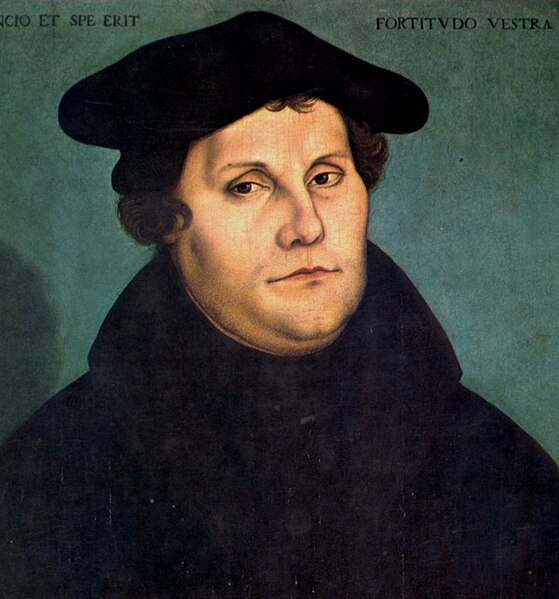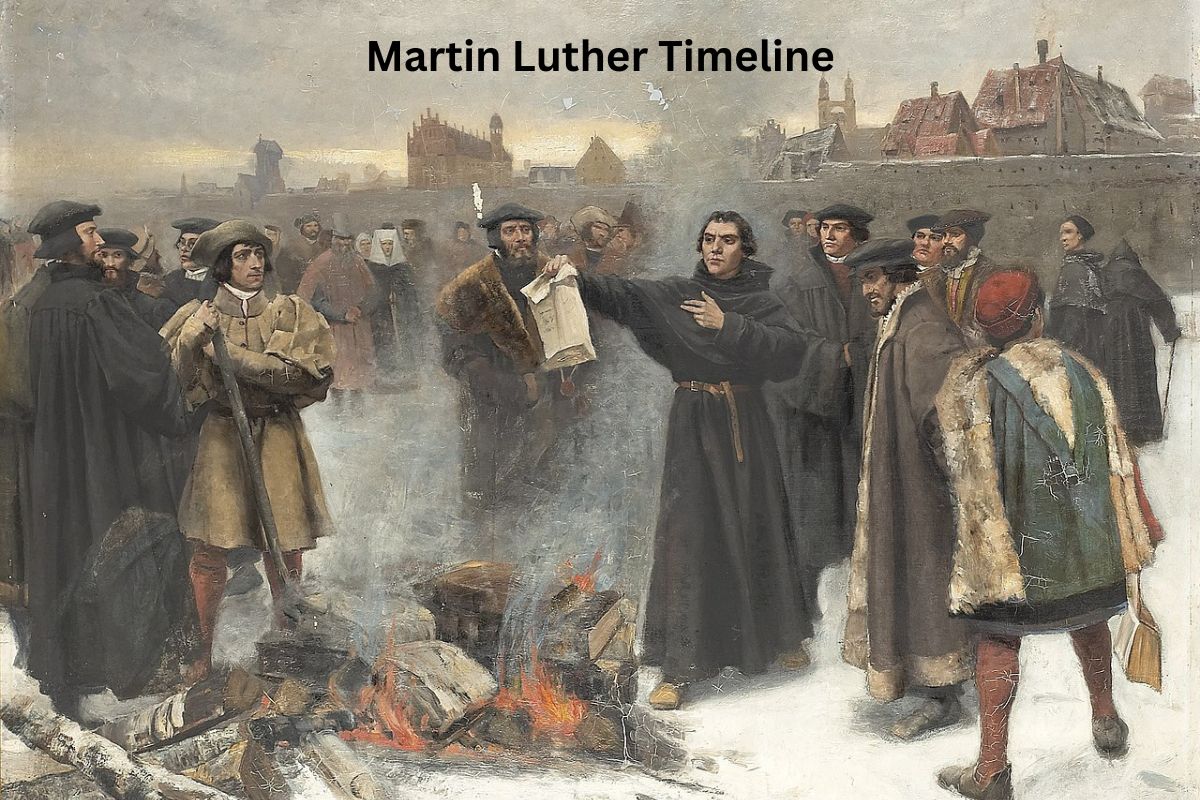Martin Luther (1483-1546) was a German theologian and key figure in the Protestant Reformation. Born in Eisleben, Germany, he became a monk and later a professor of theology at the University of Wittenberg.
In 1517, he famously posted his “95 Theses” critiquing Catholic practices, sparking the Reformation. Luther’s teachings emphasized justification by faith alone and the authority of Scripture.
He was excommunicated by the Catholic Church and declared an outlaw but continued to champion reform.
Luther married Katharina von Bora, translated the Bible into German, and authored influential catechisms and theological works.
His legacy includes the founding of Lutheranism, a major branch of Protestantism. Luther died in 1546 in Eisleben.

| Year | Event |
|---|---|
| 1483 | Martin Luther is born in Eisleben, Germany. |
| 1501 | Luther begins his studies at the University of Erfurt. |
| 1505 | Luther vows to become a monk and enters the Augustinian monastery in Erfurt. |
| 1507 | Luther is ordained as a priest. |
| 1508 | Luther begins teaching theology at the University of Wittenberg. |
| 1510 | Luther travels to Rome. |
| 1512 | Luther receives a doctorate in theology and becomes a professor at the University of Wittenberg. |
| Oct. 31, 1517 | Luther is said to have posted his “95 Theses” in Wittenberg. |
| 1518 | Luther is summoned to the Diet of Augsburg to defend his beliefs before Cardinal Thomas Cajetan. |
| 1519 | Luther debates Johann Eck at the Leipzig Debate. |
| 1520 | Luther writes “To the Christian Nobility of the German Nation,” “The Babylonian Captivity of the Church,” and “On the Freedom of a Christian.” |
| 1521 | Luther is excommunicated and declared an outlaw at the Diet of Worms, goes into hiding at Wartburg Castle. |
| 1522 | Luther translates the New Testament into German. |
| 1525 | Luther marries Katharina von Bora. |
| 1529 | Luther publishes the “Small Catechism” and the “Large Catechism.” |
| 1530 | The Augsburg Confession is presented at the Diet of Augsburg. |
| 1534 | Luther completes his translation of the entire Bible into German. |
| 1546 | Martin Luther dies in Eisleben at the age of 62. |
Timeline of Martin Luther
1483 – Martin Luther is born in Eisleben, Germany
Martin Luther was born on November 10, 1483, in Eisleben, a town in Saxony, Germany. He was born into a middle-class family.
Also Read: Martin Luther Accomplishments
His father, Hans Luther, worked as a miner and owned several copper mines. His mother, Margarethe Luther, was known for her strong and nurturing personality.

1501 – Luther begins his studies at the University of Erfurt
Luther’s parents had high hopes for him to become a lawyer, and he began his education at the University of Erfurt in 1501.
He studied the liberal arts, which included subjects like philosophy, rhetoric, and logic. He excelled in his studies and earned a Bachelor of Arts degree.
1505 – Luther vows to become a monk and enters the Augustinian monastery in Erfurt
In July 1505, while returning to Erfurt from a visit to his parents, Luther was caught in a severe thunderstorm near the village of Stotternheim.
Fearing for his life, he made a vow to St. Anne, the patron saint of miners, that he would become a monk if he survived. Luther did survive, and true to his vow, he entered the Augustinian monastery in Erfurt in July 1505.
Also Read: Reformation Facts
This decision to become a monk was a significant turning point in Luther’s life. It marked his deepening religious commitment and set him on the path to becoming a prominent figure in the history of Christianity.
1507 – Luther is ordained as a priest
After entering the Augustinian monastery in Erfurt, Martin Luther continued his religious studies and training. He progressed in his monastic life and was ordained as a priest in 1507. As a priest, he began celebrating Mass and performing other clerical duties.
1508 – Luther begins teaching theology at the University of Wittenberg
In 1508, Luther was transferred to the University of Wittenberg, where he continued his theological studies and teaching. He would spend most of his academic career at Wittenberg, which became a significant center for theological thought in the early 16th century.

1510 – Luther travels to Rome
Luther’s journey to Rome in 1510 was a pilgrimage, a common practice for monks at the time. It was during this visit to the heart of the Catholic Church that Luther began to develop critical views about the practices and corruption he observed there. This experience would later influence his reformist ideas.
1512 – Luther receives a doctorate in theology and becomes a professor at the University of Wittenberg
Luther’s academic pursuits culminated in 1512 when he received a doctorate in theology, marking him as a Doctor of the Church.
Subsequently, he became a professor of theology at the University of Wittenberg, where he lectured on topics such as the Bible and theology.
His position as a professor allowed him to delve deeper into theological matters and engage with the writings of prominent theologians of the time.
Oct. 31, 1517 – Luther is said to have posted his “95 Theses” in Wittenberg
On this fateful day, Martin Luther is traditionally believed to have nailed his “95 Theses” to the door of the Castle Church in Wittenberg.
These theses, which were actually a list of propositions for debate, criticized the sale of indulgences and raised theological questions about the nature of repentance and salvation.
This event is often regarded as the starting point of the Protestant Reformation, as it sparked a widespread debate and eventually led to Luther’s confrontation with the Catholic Church.
1518 – Luther is summoned to the Diet of Augsburg to defend his beliefs before Cardinal Thomas Cajetan
In 1518, Martin Luther was summoned to appear before Cardinal Thomas Cajetan, a representative of Pope Leo X, at the Diet of Augsburg. Cajetan demanded that Luther recant his teachings and writings.
However, Luther refused to do so, arguing that his ideas were based on Scripture and conscience. This encounter marked Luther’s growing defiance of papal authority.
1519 – Luther debates Johann Eck at the Leipzig Debate
In July 1519, Luther engaged in a theological debate with Johann Eck, a prominent Catholic theologian, at the Leipzig Debate.
This public debate focused on theological issues, including the authority of the Pope and the nature of the Church. The debate further solidified Luther’s position as a reformer and helped spread his ideas.
1520 – Luther writes “To the Christian Nobility of the German Nation,” “The Babylonian Captivity of the Church,” and “On the Freedom of a Christian”
In 1520, Luther authored three influential treatises:
- “To the Christian Nobility of the German Nation”: In this work, Luther called upon the German nobility to support the reform of the Church and challenged the idea that only the Pope had the authority to reform it.
- “The Babylonian Captivity of the Church”: This treatise criticized various sacraments of the Catholic Church, including the Mass, and emphasized the priesthood of all believers.
- “On the Freedom of a Christian”: Luther’s third treatise focused on the concept of Christian freedom and faith’s role in salvation.
These writings were widely circulated and played a significant role in the spread of Lutheran ideas.
1521 – Luther is excommunicated and declared an outlaw at the Diet of Worms, goes into hiding at Wartburg Castle
In January 1521, Pope Leo X issued a papal bull called “Exsurge Domine,” which excommunicated Martin Luther, formally cutting him off from the Catholic Church.
Later that year, in April 1521, Luther was summoned to appear before the Diet of Worms, an assembly of the Holy Roman Empire. There, he was asked to recant his teachings.
Luther famously replied, “Here I stand; I can do no other. God help me. Amen,” refusing to recant. As a result, he was declared an outlaw, and anyone was permitted to capture and punish him.
1522 – Luther translates the New Testament into German
Following the Diet of Worms, Luther’s supporters helped him escape arrest. He sought refuge at Wartburg Castle, where he adopted the pseudonym “Junker Jörg.”
During his time in hiding, Luther embarked on the monumental task of translating the New Testament from Greek into German.
This translation made the Bible accessible to the German-speaking population and had a profound impact on the development of the German language and culture.
1525 – Luther marries Katharina von Bora
In 1523, Martin Luther made one of the most personal and noteworthy decisions of his life when he married Katharina von Bora. Katharina was a former nun who had fled her convent, seeking refuge in Wittenberg.
Luther’s marriage to Katharina, a fellow ex-monastic, was seen as a significant departure from the celibate priesthood and monastic life promoted by the Catholic Church. Their union became a symbol of the Protestant emphasis on the sanctity of marriage.
1529 – Luther publishes the “Small Catechism” and the “Large Catechism”
Martin Luther recognized the need for clear and concise religious instruction for the common people. In 1529, he published the “Small Catechism” and the “Large Catechism.”
These catechisms provided a systematic explanation of Lutheran theology and served as foundational texts for the education of children and new believers. They continue to be influential in Lutheran religious education to this day.
1530 – The Augsburg Confession is presented at the Diet of Augsburg
The Augsburg Confession, written primarily by Luther’s colleague Philipp Melanchthon, was presented to Emperor Charles V at the Diet of Augsburg in 1530. It is one of the most important confessional documents of the Lutheran Church.
The Augsburg Confession outlined the key theological beliefs of Lutheranism, including justification by faith alone, the authority of Scripture, and the rejection of certain Catholic practices.
The presentation of the Augsburg Confession marked a formal declaration of Lutherans beliefs to the Holy Roman Empire.
1534 – Luther completes his translation of the entire Bible into German
Luther’s translation of the Bible into the German language, which he started while in hiding at Wartburg Castle, was completed in 1534. This translation, known as the Luther Bible, had a profound impact on the German-speaking world.
It not only made the Bible accessible to a wider audience but also played a significant role in standardizing the German language. The Luther Bible remains an important cultural and religious landmark in Germany.
1546 – Martin Luther dies in Eisleben at the age of 62
Luther passed away on February 18, 1546, in his hometown of Eisleben, Germany, at the age of 62. His death marked the end of a life devoted to theological reform and the establishment of Lutheranism as a distinct branch of Protestant Christianity.
Martin Luther’s legacy lived on through his writings, teachings, and the Lutheran Church, which continued to grow and evolve in the centuries that followed.
